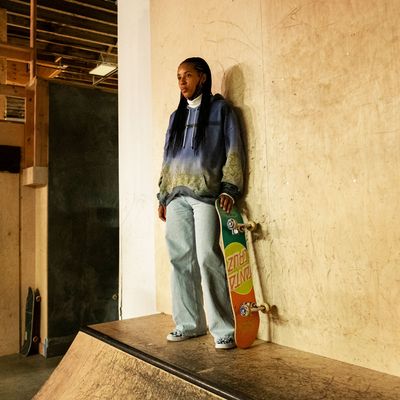
Most people can’t fly, but the women of Betty can.
At least it looks that way when these skateboarders glide through the streets, positioned by director and series creator Crystal Moselle in the bottom third of the frame beneath a New York City sky that stretches as far as the potential in an unpredictable evening. With their feet rooted to their boards and an ability to whoosh in any given direction, they exist as both abiders and defiers of gravity, as the visual definition of freedom.
That was the case in season one of Betty and in Moselle’s 2018 movie Skate Kitchen, which inspired this HBO series. It’s also true in Betty’s second season, which arrives on Friday. But as in the real New York — and the whole world — this time, freedom comes with caveats.
The six vibrant new episodes of Betty take place in the late summer and fall of 2020, which means the pandemic’s presence is very much felt. Many of the characters wear masks, although one wishes they would wear them more consistently indoors and in close proximity to others. Perhaps for the sake of capturing the actors’ expressions on-camera, the face coverings often dangle around the chin instead of protecting mouths and nostrils. There are references to PPE loans being denied, leases being terminated, and COVID violations in progress. In the first episode, Indigo (Ajani Russell), who’s working at a grocery store, gets into an altercation with a white customer who refuses to wear a mask, claiming she has a “medical condition.” This lady is one iPhone video away from being called out as a Karen on social media, and her behavior prompts Indigo to quit and try to make money through means that require even more moral compromises on her part.
Later in the season, Indigo reaches a breaking point at a Halloween party. (And no, they shouldn’t be having a Halloween party! Betty doesn’t necessarily condone the main characters’ sometimes casual attitude toward pandemic safety, but it doesn’t outright condemn it, either; the show’s eye stays on reality, and the reality is that these young people may very well toggle between being responsible and a little lax, especially during that pre-holiday-season period when cases were lower.) “I don’t know if it’s Breonna Taylor, COVID, or my mom,” Indigo says to Janay (Dede Lovelace). “But it’s just—”
“It’s a lot,” Janay says, finishing her sentence.
The stress on everyone is more sharply felt this season. In almost all of the story lines that affect the five main characters — Indigo, Janay, Camille (Rachelle Vinberg), Honeybear (Kabrina “Moonbear” Adams), and Kirt (Nina Moran) — there are moments when people or entities that once seemed reliable betray the trust these skater girls turned women have placed in them. Access to the warehouse their community has been using as an indoor skate park gets cut off, forcing them to find a new venue. Janay takes the lead on that effort and gets frustrated when her peers are not as enthusiastic about taking direction from her as she wants them to be. Camille becomes a brand ambassador for a semi-upscale skater-apparel store and worries that it’s killing her authenticity. Indigo starts getting paid to go on dates with wealthy men and has to work harder to maintain the boundaries she sets in those encounters.
The worries and intensity that come with more mature sexual relationships are an issue for more than one of the Betty posse but especially for Honeybear, whose girlfriend, Ash (Katerina Tannenbaum), persuades her to turn their partnership from couple to throuple, which sparks unanticipated feelings of insecurity. The least believable and most amusing arc belongs to Kirt, the spacey, blunt-talking stoner whose head has never been seen publicly without a backward baseball cap perched on top of it. Convinced that she has a mission she’s supposed to fulfill, Kirt unwittingly becomes the romantic guru to a bunch of bros who base their understanding of women, and eventually even themselves, on whatever Kirt tells them.
“You also have a period,” Kirt earnestly explains while all these dudes hang on her every syllable. “The moon pulls on your balls, too, just like the tides.”
Each of the actors in Betty plays a character loosely based on themselves, but that doesn’t take away from the nuance and sensitivity they bring to their performances. Russell is especially a standout this season, projecting confidence and doubt on a dime depending on how she blinks her lashes or sips on a straw. Every one of these women is a low-key iconoclast with an Instagram-worthy sense of style that’s too cool for Instagram. (Honeybear’s ensembles, from the patterns in her scarves and face masks to the signature pasties she wears over her nipples, are worthy of intense, uninterrupted study.)
But what remains most extraordinary about Betty is the way it places the viewer so viscerally in New York. Even if you haven’t been in the city proper in months, you’ll be pulled back instantly by the way Moselle’s warm vérité style travels through parking-lot dance parties, rests on the Staten Island Ferry, and pops into bodegas. She understands, on an instinctive level, how to record the exact rhythms of life in Manhattan and its boroughs. (After a neighborhood bodega owner throws the women out of her store for not masking up properly — “Put your masks on, and get the fuck out!” — she follows up as they leave with a friendly and sincere “Love you!”)
Season two of Betty, landing at the perfect time as we begin to come out of our pandemic hidey-holes and back into the sunlight, shows us a New York where the pandemic has shaken the foundations but where objects in motion remain in motion. Just like these striving, sturdy women who glide-fly down the sidewalks, this city knows that often the best thing you can do, even in stressful times, is to just keep rolling.


